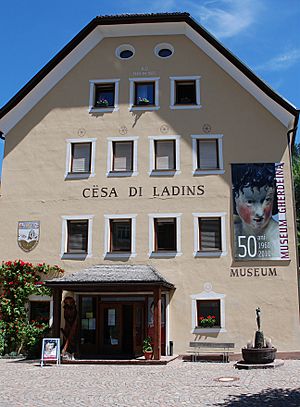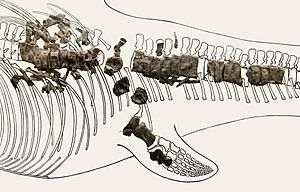Museum Gherdëina facts for kids
 |
|
| Lua error in Module:Location_map at line 420: attempt to index field 'wikibase' (a nil value). | |
| Established | 1960 |
|---|---|
| Location | Urtijëi |
| Type | Archeology, geology, history, toys |
The Gherdëina Local Heritage Museum is a cool place to visit in Urtijëi, a town in northern Italy. It opened its doors in 1960 inside a building called the Cësa di Ladins. This building is also home to the Union di Ladins de Gherdëina, a group that works to protect the Ladin language and culture in the Val Gherdëina area. There's even a library there focused on Ladin language and history!
The museum is packed with amazing collections that show you all about the culture and nature of Val Gherdëina. You can explore two floors filled with different exhibits. These include beautiful wood carvings from the last 300 years, old wooden toys made right there, paintings by local artists, and cool finds from ancient times. You'll also see fossils, minerals, and learn about the plants and animals of the region.
Contents
Exploring the Museum
Welcome to the Museum!
When you first step into the museum, you'll see some special art pieces. These include a large wooden cross called the Crucifix of Sëurasass, made in 1932 by Baptist Walpoth and Vinzenz Peristi. There's also an oil painting by Josef Moroder-Lusenberg that shows what Urtijëi looked like way back in 1860. Plus, you can see three modern paintings by Franz Noflaner.
Art from St. James Church
The first room you enter has original sculptures from the St. James Church in Urtijëi. These were made by famous artists named Melchior (who lived from 1622 to 1689) and Kassian Vinazer (1710 to 1789). The Vinazer family was a big deal in wood carving in Gherdëina, and they really shaped the art of the area. You'll also see the original altarpiece from the church, painted in 1751 by Franz Sebald Unterberger. It shows the Virgin Mary with her child, along with Saint James and Saint Henry.
Amazing Wooden Sculptures
The second room is all about the history of wood carving in Gherdëina. You'll see works from the very first famous carving families, like the Trebinger family (1580–1689) and the Vinazer family (1622–1817). There's even a sculpture of Saint Philomena of Rome by Dominik Mahlknecht (1796–1876). The room also features art from 20th-century sculptors like Albin Pitscheider and Vinzenz Peristi.
You'll find many smaller sculptures here too, from the 1700s to the mid-1900s. These include unique clock stands, funny caricatures, and figures that represent ideas. There are also beautiful nativity scenes and animal figurines. A special part of this collection is 120 figures carved by Albin Pitscheider (1877–1962), which his daughters gave to the museum. You can also see paintings by Josef Moroder-Lusenberg (1846–1939) and other local artists.
Natural Wonders of the Dolomites
The third room is dedicated to the natural world. Here, you can learn how the mountains of the western Dolomites were formed. There are helpful charts and pictures, along with a collection of local fossils, rocks, and minerals. Look out for fossilized plants called Ortiseia, different snail shell prints, and a fossilized fish. A really cool exhibit is the reconstructed skeleton of an Ichthyosaurus, which was a giant sea reptile! You can also see ancient coral and ammonites, which are spiral-shelled creatures.
This room also has a display of local minerals, including some from Mont Sëuc. You'll also find minerals from other mountain areas and even from other countries. These include sparkling rock crystal, colorful garnet, and purple amethyst.
In the same room, another section shows you the amazing variety of alpine plants and animals. You can see a collection of dried plants (a herbarium) and stuffed animals, like a rare albino roe deer and local birds. There's also a beautiful collection of butterflies.
As you go up the stairs to the second floor, you'll see a special cloth called the Fastentuch (Lenten cloth). It's from the St. James Church and dates back to the early 1600s.
Old Wooden Toys
This room is a favorite for many visitors because it's full of old wooden toys from Gherdëina! This collection was mostly put together by Johann Senoner-Vastlé before World War II. It shows a great variety of toys made in Gherdëina between 1750 and 1940. You can see many different sizes of the typical Gherdëina jointed doll, also known as a dutch doll, peg doll, or stick doll.
Ancient History of Gherdëina
A special part of the second floor is all about the ancient history of the valley. You can see amazing Stone Age tools made of flint from a place called Plan de Frea. These are some of the oldest traces of humans found in the Gherdëina region, dating back about 7,000 to 5,000 years BC.
There are also items from the Bronze Age (around 1700 to 750 BC), like a bronze dagger from the Balest mountain and bronze needles from Resciesa and Mastlé. From the Iron Age (400 to 15 BC), you'll see finds from a large site called Col de Flam near Urtijëi. These include burial items like pins (fibulae), rings, iron spearheads, glass beads, and bronze pendants, along with various tools.
Luis Trenker's Legacy
Also on the second floor, there's a section dedicated to Luis Trenker. He was a famous writer, actor, film director, and rock climber from Urtijëi (born in 1894, passed away in 1990). This exhibit shows his personal belongings, awards for bravery, film prizes (like the Golden Globe), and other items from his personal collection. His family gave these items to the museum in 2004.
Images for kids






